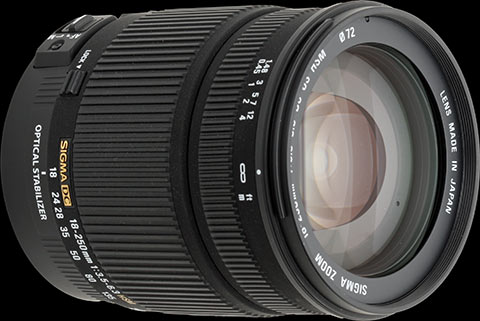 Sigma’s 18–250mm f/3.5–6.3 DC OS HSM zoom lens represents a conscious effort to remain competitive in the marketplace battle of super-zoom lenses, and even up the ante a bit. Part 1 of this PhotographyTalk.com article examined a number of features and capabilities of the Sigma lens and how they compare to equivalent lenses from Tamron, Canon and Nikon. Part 2 continues the examination, focusing on additional features that will help any consumer understand if the Sigma 18–250mm zoom is a good match with his or her type of digital photography.
Sigma’s 18–250mm f/3.5–6.3 DC OS HSM zoom lens represents a conscious effort to remain competitive in the marketplace battle of super-zoom lenses, and even up the ante a bit. Part 1 of this PhotographyTalk.com article examined a number of features and capabilities of the Sigma lens and how they compare to equivalent lenses from Tamron, Canon and Nikon. Part 2 continues the examination, focusing on additional features that will help any consumer understand if the Sigma 18–250mm zoom is a good match with his or her type of digital photography.
Nikon D600 | Nikon D7100 | Nikon D800 | Canon 5D Mark III | Canon EOS-Rebel T4i
Hypersonic Auto-Focus
Sigma has included its extremely-quiet Hypersonic Motor (HSM) to operate the auto-focus feature; and its proven to be better than the Tamron 18–270mm and neck-and-neck with the Canon and Nikon lenses, similarly equipped. Of particular note is how quick and precise the HSM functions at the fully extended telephoto focal length. This makes the Sigma 18–250mm OS zoom lens a serious consideration for photographers who shoot many photos with moving subjects or objects, from children playing in the backyard to athletics, animals and other high-speed activities.
The Effect of Focus Distance on Relative Focal Length
It’s a standard characteristic of super-zoom lens, such as the Sigma and its competitors, to have an angle of view that quickly widens as you focus from infinity to 0.45m. This is especially noticeable at the telephoto end. Change the focus distance to 2m, however, and the relative focal length of this super-zoom lens is actually approximately 180mm, not 250mm. Because of this “quirk,” focusing on far scenes or subjects means this lens will operate at an actual 250mm. When they lose real focal length at the much wider angle of view, the solution is simply to move toward the subject, which many photography enthusiasts and hobbyists need to do anyway to improve all of their photos.
Conclusion
The Upside List
- Huge 13.9x focal length range; ideal general purpose and travel lens.
- Good image quality in the wide to short telephoto range.
- Fast auto-focus, with Hypersonic Motor (HSM).
- Low distortion (for a super zoom).
- Good build quality, smooth zooming action and no zoom creep.
- Available for Canon, Nikon, Pentax, Sigma and Sony mounts (APS-C/DX format DSLRs only).
- In-lens Optical Stabilization (OS) system, including Pentax and Sony versions.
The Downside List
- Very inconsistent sharpness through the zoom range; extremely soft at 135mm.
- Soft corners at almost all focal lengths.
- Image stabilization not as effective as on similar lenses, especially at telephoto end.
When it comes time to decide if you should buy the Sigma 18–250mm F3.5–6.3 DC OS HSM, zoom lens, the process is similar to choosing any better photo equipment. None of it is perfect, or perfect for every photographer; so it’s always a matter of exactly which features and capabilities are absolutely necessary and which you are willing to lose to have those you must. For example, if you require extreme sharpness, then the Sigma lens can’t deliver it, but it will give you comparably lower distortion and chromatic aberration.
Compare the functionality of the Sigma 18–250mm with its Canon, Nikon and other competitors and there isn’t much difference in auto-focus and zoom action. The benefit here is that the Sigma, at approximately $450–$500, costs less than its competitors, which could be a prime criterion for many photographers.
If optical stabilization is critical to the type of photography you like to shoot, then the Sigma lens’ OS technology probably won’t perform to your standards. Third-party testing indicates that Sigma’s claim of four stops better is, in reality, actually only two stops at the telephoto end, while the wide end does provide three stops. When you consider the poor performing OS at a telephoto focal length, which means a slow f/6.3 aperture is required, this lens can only do its best work on a fully sunny day. Shoot with the Sigma under low exterior light, such as a cloudy weather, and you’ll have to increase the ISO setting.
For many photographers, the choice will be either the Sigma 18–250mm OS zoom lens or its most-comparable competitor, the Tamron 18-270mm F3.5-6.3 Di-II VC. It’s not an easy choice, since the Tamron produces somewhat sharper images with better optical stabilization technology, while the Sigma looks and feels more substantial and has a considerably faster and quieter auto-focus.
Recommended Reading:
- Understanding Exposure, 3rd Edition: How to Shoot Great Photographs with Any Camera
- The Complete Photo Manual: 300+ Skills and Tips for Making Great Pictures
- 50 Photo Projects - Ideas to Kickstart Your Photography
- Photo Op: 52 Inspirational Projects for the Adventurous Image-maker
- The Print and the Process: Taking Compelling Photographs from Vision to Expression
